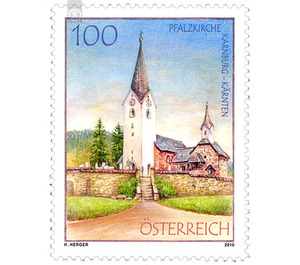churches - Austria / II. Republic of Austria 2010 - 100 Euro Cent
Theme: Architecture
| Country | Austria / II. Republic of Austria |
| Issue Date | 2010 |
| Face Value | 100.00 |
| Edition Issued | 300,000 |
| Printing Type | offset |
| Stamp Type | Commemorative |
| Item Type | Stamp |
| Chronological Issue Number | 2214 |
| Chronological Chapter | OOS-OE2 |
| SID | 622896 |
| In 58 Wishlists | |
With the new special stamp "Pfalzkirche von Karnburg" the series "Churches from Austria" now finds its attractive beginning. Karnburg, located about five kilometers north of the Carinthian capital Klagenfurt at the foot of Ulrichsberg, is a small village in the market town of Maria Saal. In the Middle Ages Karnburg, which today has nearly 600 inhabitants, was the center of the Alpine Slavic principality of Karantania. On a plateau was once a Carolingian royal court (Curtis Carantana); With the colonization of Carinthia by the Bavarians, it finally became a Carolingian Palatinate. The "Fürstenstein", which was important both for the establishment of the Slavic princes and later of the Carinthian dukes, was located in Blasfeld, to the northwest of the parish church, until 1862. The Palatinate Church in Karnburg - dedicated to Saints Peter and Paul - is not only the oldest church in the diocese of Gurk / Klagenfurt, it is also one of the oldest Austrian churches. The construction of the church was built before 888, the first written mention goes back to the year 927. The medium-sized religious building is connected by the southern sacristy via a passageway to the gothic Annakapelle (this dates from the 14th century). An almost square, but heavily warped and not in the main axis chancel adjoins a rectangular hall room. The triumphal arch to the nave originally opened in an overcircuit. For the construction of the church numerous Roman relief and inscription stones were used; Remains of Romanesque murals from the 13th century have been preserved to this day. On the north wall of the church is a walled-in entrance, and above that you can see a remarkable detail: a pre-Romanesque stone relief designed to represent the hand of God. From the village up to the Pfalzkirche leads a footpath, which is bordered by the fourteen stations of a Way of the Cross with picture benches of the Passion of Jesus Christ. A crucifixion group near the church is the fifteenth place of worship and the end of the Passion Way. The good state of preservation of the Palatinate Church of Karnburg is primarily due to two comprehensive restorations from 1928 and 1970.


